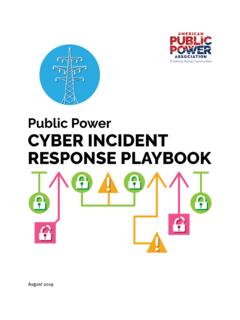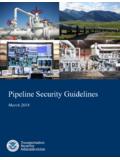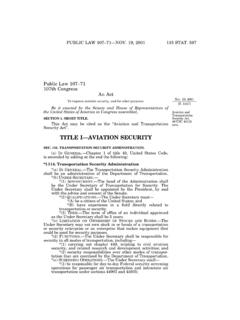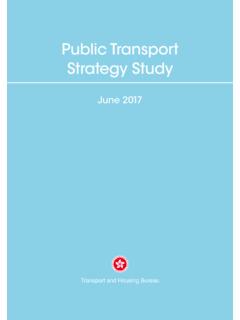Transcription of A Public Power System's Introduction to the Federal Energy ...
1 Public Utility Accounting A Public Power System's Introduction to the Federal Energy Regulatory Commission Uniform System of Accounts Copyright 2012 by the American Public Power Association All rights reserved. Published by the American Public Power Association 2451 Crystal Drive - Suite 1000 Arlington, VA 22202-4804i Table of Contents Acknowledgements .. iii Chapter 1 Introduction ..1 Purpose of this Guide .. 3 Are Utilities Required to Use the FERC Accounting System? .. 3 Benefits of Using the FERC Uniform System of Accounts .. 4 Capital versus O&M Why Does this Matter? .. 5 Common Example of a Utility s Account Structure .. 5 Chapter 2 Accounting Information for Public Power Systems .. 7 Uses and Users of Electric Utility Accounting Information .. 9 Origin of FERC Uniform System of Accounts .. 11 The Different Types of Electric Utilities .. 13 Accounting for Public Power Systems .. 15 Why Public Power Systems Should Use the FERC USOA .. 16 Implementation of the FERC USOA.
2 17 FERC USOA An Activity Based System .. 18 Chapter 3 FERC Uniform System of Accounts: Instructions .. 19 Overview of Instructions .. 21 Definitions .. 21 General Instructions .. 22 Understanding the FERC Numbering System .. 25 Electric Plant Instructions .. 26 Operating Expense Instructions .. 29 Capitalization Policies .. 30 Sample Utility .. 31 Chapter 4 FERC Uniform System of Accounts: Balance Sheet .. 33 Balance Sheet .. 35 Assets and Other Debits .. 37 Utility Plant ..37 Other Property and Investments .. 41 Current and Accrued Assets .. 41 Deferred Debits .. 42 Liabilities and Owners' Equity .. 43 Proprietary Capital .. 43 Long-term Debt (including bond ratings and factors that impact) .. 44 Other Noncurrent Liabilities .. 44 Current and Accrued 44 Deferred 45 A USOA Balance Sheet .. 45 ii Chapter 5 FERC USOA: Income Statement Accounts .. 49 Income Statement .. 51 Utility Operating 54 Operating Revenues .. 55 Operation and Maintenance Expenses .. 56 Other Utility Operating Income and Expenses.
3 62 Other Income and Deductions .. 62 Interest Charges .. 63 Extraordinary Items .. 64 A USOA Income Statement .. 65 Chapter 6 Introduction to Accounting Applications .. 71 Human Resources/Payroll .. 73 Accounting for Labor Costs .. 74 Labor Accounting Illustration .. 75 Labor Loadings .. 77 Labor Clearing Accounts .. 78 Materials and Supplies Inventory .. 79 Accounting for Materials and Supplies .. 79 Materials Inventory Illustration .. 79 Materials Loadings .. 83 Transportation and Power Operated Equipment Usage .. 84 Accounting for Transportation and Equipment Costs .. 84 Transportation Accounting 86 Chapter 7 Introduction to Accounting for Utility Property .. 87 Work Order (Capital Project) Accounting .. 89 Components of Construction Cost .. 90 Overheads 92 Allowance for Funds Used During 93 Retirement Work Orders .. 95 Work Order 95 Property Retirements .. 98 Chapter 8 Introduction to Basic Rate Design .. 101 Objectives of Rate Design .. 103 Key Rate Design and Funding Concepts.
4 104 Understanding Costs .. 104 Common Rate Mechanisms .. 105 Sources of Information iii Acknowledgements This Public Utility Accounting guide was originally written by Brian Farber, with Burns & McDonnell in Kansas City, Missouri. The manual was updated in 2012 by Jerry McKenzie, with MGT of America, Inc. In updating this publication, Jerry brought to bear his thirty plus years of knowledge of electr ic utility accounting, as well as specific experience working with both Public Power systems as well as investor-owned electric utilities. Public Utility Accounting Chapter 1 Introduction Chapter 1-- Introduction Public Utility Accounting Page 3 Purpose of this Guide The purpose of this guide is to provide the management and staff of Public Power systems with an overview of generally accepted electric utility accounting practices within the Federal Energy Regulatory Commission (FERC) prescribed Uniform System of Accounts (USOA). The guide discusses why and how this accounting system should be implemented by Public Power systems.
5 The FERC USOA is similar to most other prescribed systems of accounts and is the most widely used and referenced accounting system by the nation's electric utilities. As such, it serves as the industry standard that provides valuable comparative information, often used for benchmarking and other similar performance measurement and analysis. The FERC USOA does not preclude a utility from tailoring its accounting system to its needs, but, as mentioned above, provides a standard framework on which each utility's accounting system is to be based. This framework of standard accounting facilitates the financial comparison of utilities at either a summary level or at a significant level of detail. Unique systems of accounts and accounting procedures are often established within the FERC framework by each utility. This design allows them to meet the information requirements of that utility's system and, if appropriate, those of specific local regulatory jurisdictions under which they are regulated.
6 Although this guide is not intended to define all specific detailed accounting practices which may apply to Public Power utilities, it does provide a general representation of the standard application of the FERC USOA by the industry today. This guide provides an introductory view of various uses of electric utility financial information, with a detailed review of the FERC USOA and how these information requirements can be met under the FERC system. It also discusses the implementation of the USOA by Public Power systems. The guide will address the following areas: Origin and purpose of the USOA; Reasons why Public Power systems should use the USOA; and Structure of and instructions for using the USOA In addition, the guide serves as an Introduction to specific accounting applications under the FERC USOA. Much of the information provided in this guide is available in various utility industry publications and general reference materials.
7 This guide attempts to bring this information together, as it relates to Public Power systems, in a concise form. A list of some of these sources, which were used in the preparation of this guide, is included in the Sources of Information. Are Utilities Required to Use the FERC Uniform System of Accounts? Many Public utility accountants ask whether all utilities are required to adopt the uniform system of accounts. The simple answer is no. Specifically, the FERC says the USOA is applicable to all licensees subject to the Commission's accounting requirements under the Federal Power Act, and to all Public utilities subject to the provisions of the Federal Power Act. It is applicable to Public utilities that own or operate facilities subject to the Federal Power Act, and to licensees engaged in the generation and sale of electric Energy for ultimate distribution to the Public . Readers should note that a Public Utility as Chapter 1-- Introduction Page 4 Public Utility Accounting defined here means any person who owns or operates facilities subject to the jurisdiction of the Commission under the Federal Power Act (section 201(e) of said act).
8 The USOA also applies to agencies of the United States engaged in the generation and sale of electric Energy for ultimate distribution to the Public , so far as may be practicable, in accordance with applicable statutes. It is clear from the FERC's definition that many Public Power systems that do not have a license agreement with the Federal government for Energy resources are not required to adopt the uniform system of accounts. But other jurisdictions may mandate that a particular electric utility follow FERC s uniform system of accounts. In some cases, either the state statutes or city ordinances mandate that USOA be adopted. Although most Public Power systems are locally regulated by an elected or appointed board of consumer- owners, in six states they are also regulated by the state Public service commission. Some bond covenants used in obtaining external sources of financing commit the electric utility to adopt the FERC Uniform System of Accounts.
9 Consequently, these additional jurisdictions and covenants have the effect of enlarging the number of electric utilities subject to the FERC USOA. For regulated utilities, the FERC Uniform System of Accounts or the similar. National Association of Regulatory Utility Commissioners' (NARUC) Uniform System of Accounts have been adopted in virtually every state with minor exceptions necessary to meet particular state requirements. Rural electric cooperatives are required to maintain their accounting records in accordance with the Rural Utility Services (RUS) Uniform System of Accounts, which is similar to that required by the FERC. In fact, except for specific instances in which RUS prescribes other accounting, any changes in the FERC Uniform System of Accounts are considered changes in the RUS system. Benefits of Using the FERC Uniform System of Accounts For those Public Power systems that are not required to adopt the FERC Uniform System of Accounts, there is the question of the USOA's value to a publicly owned electric utility.
10 This guide, although not all-encompassing, outlines for Public Power systems some of the significant benefits of using the USOA. One reason to adopt the FERC system for voluntary compliance is comparability. By using the industry standard chart of accounts, a utility accountant (and management) can effectively compare operating statistics with those of other utilities. These measurements of operating efficiency can be extremely helpful in identifying operational (financial) problems at an early stage. When examining utility costs, it is very beneficial to use the same "language" in defining costs that other utility accountants use. In the absence of this common "language," comparisons of such costs as "administrative and general expenses," can be very misleading. Nearly all electric utilities are required to complete some form of a standardized annual report to an oversight body, generally at the state level. These forms are often organized in a format consistent with the FERC Uniform System of Accounts.










